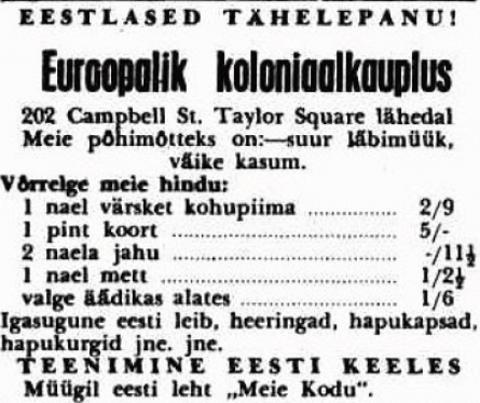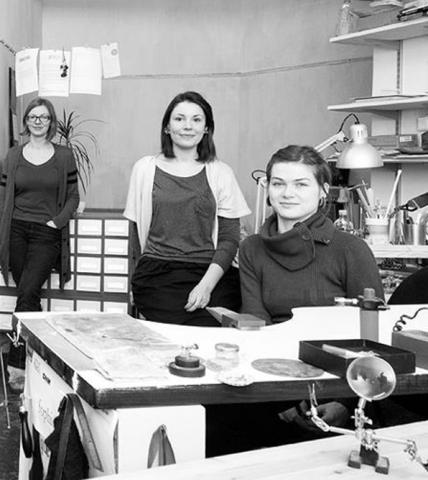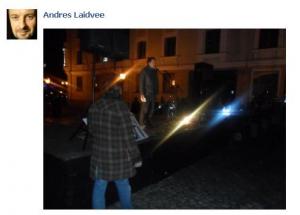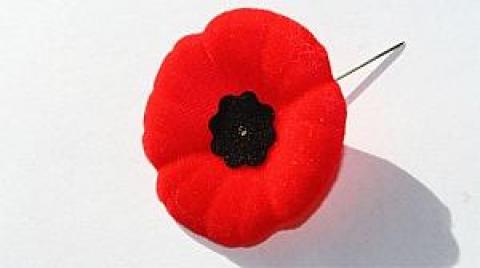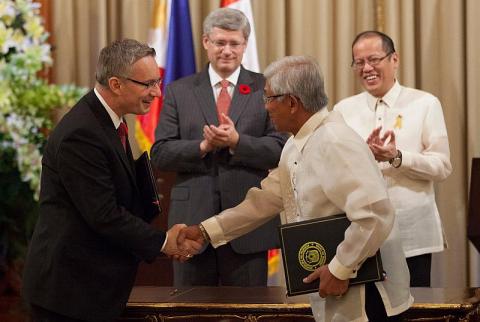18. augusti Los Angeles Times (www.latimes.com) reisi rubriigis ilmus Eestile ja eriti Tallinnale positiivne reisiarvustus. Jagame seda siinkohal ka Eesti Elu lugejatega.
------------
By KRISTIN L. JOHANNSEN TALLINN, Estonia -- Street vendors' cries, colored banners flying, footsteps hurrying across cobblestones, a Babel of foreign tongues, merchants hanging woolens under the town wall. These were the sights and sounds of Tallinn 700 years ago--and they still are.
Since Estonia broke away from the Soviet Union in 1991, its capital has proudly gone back in time. Not to the country's first brief period of independence, between the two world wars, but to its glory years in the Middle Ages. Then it was one of the wealthiest cities on the Continent as a member of the powerful Hanseatic League, which controlled commercial activity in northern Europe.
In June my husband, Kevin, and I spent three days soaking up the city's medieval atmosphere while on a trip to other countries along the Baltic Sea. Estonia is the size of Switzerland and has a population of only 1.4 million. Along with its Baltic neighbors Latvia and Lithuania, it was dominated by German traders for centuries before falling to imperial Russia. The country gained independence in 1920 only to be occupied by Hitler's army in 1941, then swallowed up by the Soviet Union in 1944.
Finally free to set their own course, Estonians now are celebrating their past. A modern, almost Scandinavian-looking city of low-rise glass office buildings and apartment blocks fades into blocky Soviet-era suburbs beyond the massive stone wall of the old town. I found it hard to believe that the Gulf of Finland once washed the gates of medieval Tallinn. Tea Reinald, our guide, explained that over the centuries geological forces have caused the land to rise 2 millimeters per year, pushing back the coastline and enabling the city to grow from its ancient heart on the hill called Toompea, where we started our walk.
Though an Estonian settlement existed here more than 1,000 years ago, Tallinn entered recorded history when it was invaded and Christianized by the Danes in 1219. Tallinn means "Danish city" in Estonian. The city's key location on the eastern shore of the Gulf of Finland made it attractive to the Germans, Swedes and Russians, all of whom later fought over and controlled Estonia at different periods, leaving their mark on the capital.
From the top of the hill, we looked down on the 13th century wall and four of the stout watchtowers that protected the wealthy town from invasion. One huge round tower received its peculiar name, "Kiek in de Kok" ("peek into the kitchen," in the German dialect of the Hanseatic traders), because its high windows enabled guards to watch the goings-on in houses below. Nearby, the Maiden Tower was supposedly a prison for prostitutes. Nowadays it contains a cafe.
During the Middle Ages the aristocracy and clergy crowded together on the hill, while the city's businessmen traded below. In a way, that's still true. As we walked around Toompea, Reinald pointed out the pink classical façade of the palace where the Estonian parliament meets, opposite Alexander Nevsky Orthodox Cathedral, which serves the Russian minority left behind in the city after the collapse of the Soviet Union.
Nearby, the Dome Church, Tallinn's oldest (dating to 1233), was a work in progress for more than 500 years. Its stern, whitewashed Gothic walls didn't get their ornate steeple until 1779, a Baroque fantasia of domes and cupolas with a needle-sharp spire piercing a gleaming golden ball.
In the Middle Ages, only two roads led from Toompea into the lower town. The Gate of "Short Leg Street," for pedestrians, was locked at 9 every night to keep riffraff off the hill. Like privileged aristocrats, we followed "Long Leg Street," the carriage route, down toward Raekoja Plats, the town hall square. As noon chimed on the clock of the town hall, the cobblestoned square bustled, as it must have in Hanseatic days. Visitors from distant lands gawked up at the lofty church spires, and a woman in a blue velvet gown tried to lure travelers into her tavern. Adding a modern touch were two Hare Krishna devotees offering Indian sweets to baffled passersby.
Customers hurried into the Raeapteek, a pharmacy that was operating in the same spot in 1422. Now they were stocking up on aspirin and toothpaste instead of unicorn horn and pulverized gemstones. But the pharmacy's mini-museum shows off its centuries-old apothecary jars, labeled in Latin, and wood contraptions for making pills.
_ _ _
Nearby, the newly revamped Tallinn City Museum, in the thick-walled house of a merchant built in 1363, explains all about the Hanseatic League with hands-on displays. At its peak from the 13th through 15th centuries, the league was a confederation of 100 German-founded trading cities stretching from the Norwegian fiords to the heartland of Russia. The Hanseatic League operated something like the European Union, permitting free trade across national borders.
Tallinn was particularly wealthy because Hanseatic law required all trade between east and west to be weighed and reloaded there. From Russia, barrels of honey and furs, bales of flax and slabs of wax passed through the city. (Hundreds of tons of beeswax were needed annually to make candles for the Catholic churches of Europe.) In turn, woven fabrics, silver, hops for beer and sea salt were shipped east. One archeological dig here found coins from China, Scandinavia, the Byzantine Empire and Germany jumbled together.
The museum's exhibits don't end with the city's medieval past. On the top floor we were fascinated to find the Soviet era encapsulated in displays with sardonic English titles like "Buying Power" (shoddy clothes, with the abacus used to sell them) and "Three Bearded Ones" (kitsch portraying communism's founders, Marx, Engels and Lenin). At the final display, a group of Estonian teenagers sat mesmerized by video news footage of the 1991 struggle for independence.
With our guide, we visited the Song Festival Grounds, an enormous outdoor theater where the independence movement was launched 15 years ago.
The 1980s, Reinald said, was a decade of national reawakening, with Estonians becoming more conscious of their national identity and hungry for independence. Their revolution took off on an unusual note, proving, in this case at least, that the voice is mightier than the sword. In September 1988, a folk song festival--folk singing has long been dear to Baltic hearts--at the theater suddenly turned political. More than 300,000 people began singing the Estonian national anthem, forbidden under Soviet rule.
"I was there," Reinald said. "People held hands and had tears in their eyes. It was a very emotional thing."
Between rounds of patriotic songs, participants held political meetings. Later song festivals drew even more people into the nonviolent protest, culminating in a chain of 3 million people that stretched nearly 300 miles across the three Baltic countries--half their total populations.
Today Estonians are justly proud of their "singing revolution," which won them independence without the loss of a single life.
_ _ _
In Tallinn, even shopping has medieval overtones. Alongside the usual modern shops selling specialties like woodcarvings, Baltic amber jewelry and linen, we found an ancient passageway crammed with artists' workshops and galleries owned by the Katariina Gild. The members' work (including silver jewelry, quilts and handmade hats) is top quality, but some of the craftsmen could use a lesson in free-market etiquette. One gallery owner greeted me by saying, "What are you doing here?"
I got a warmer reception at the "wall of sweaters," a narrow lane where heaps of woolens glow under the ancient arches of the town wall. Not everything was handmade, but the designs were appealing, from cats to snowflakes to traditional geometric motifs. And the price was right; some hand-knit sweaters were less than $50.
Despite its pride in its past, Estonia is hardly mired in quaintness. It's a comprehensively wired (and wireless) nation. Rates of cell phone and Internet usage are the highest in Eastern Europe, and I easily found an Internet cafe to check my e-mail. As I struggled with the unfamiliar keyboard, a 9-year-old boy at the next computer gave me helpful advice in perfect English without looking up from the game he was playing. He then started explaining all the different types of weapons in his game.
"Your English is really good," I told him.
"I know," he said, and went back to buying a sword.
On our last evening in Tallinn, we decided to splurge, and joined a group of travelers for a medieval banquet at a restaurant called Olde Hansa. At the top of a long stairway, we entered a shadowy room lighted only by white candles that poured torrents of wax onto tables and shelves. The plastered walls bore medieval murals, and the dark beamed ceiling hung low over our heads. Through the noisy mob of diners, we could hear the wail of medieval music.
"Good evening, merchants!" our waitress yelled above the din. She looked like a recent arrival from another century, a young woman in a long red gown with a white snood over her blond hair and a leather purse at her waist. She scolded us for our dirty hands, then poured warm water into a basin for us to wash them before we took our seats on stools at a long wood table.
Our serving wench, wearing appropriately saucy smiles, fetched course after course. We shared spiced walnut bread, huge olives, jet-black rye bread, cream cheese, sweet saffron pickles, sour herbed pickles, horseradish sauce, jam made from bitter red berries. She brought us white wine and stoneware mugs of cinnamon beer that took both hands to lift. Next came a bowl of fresh cheese curds in warm herb sauce, and more bread.
Those were just the appetizers. After an hour or so, we finally reached the main courses: "game pot" (a rich stew of wild boar and elk), a mound of chicken legs with almonds, and accompaniments of spiced lentils, turnips, barley with hazelnuts and a wonderful smoked sauerkraut. I had just decided that medieval food was not so strange after all when dessert arrived: a bowl of melted cheese topped with sickly-sweet carrot jam. It was, well, unique.
According to the menu, this is what they ate in 1450, and the authenticity is no accident. A noted local historian is a consultant to the restaurant, which has a branch in the former Hanseatic city of Bergen, Norway.
Around us, there was jovial yelling in many languages as people approached the bottom of those vast mugs of beer. We were sinking at last into the mellow, candle-lighted glow when, at the next long table, a dozen men began singing loudly (and drunkenly).
First I was annoyed because their racket made conversation impossible. But then I had to laugh. After all, what could be more authentic?
Kristin L. Johannsen is a freelance writer in Berea, Ky.
In Tallinn, Celebrating Medieval Times
Kuumad uudised | 19 Aug 2002 | EWR
Kuumad uudised
TRENDING






